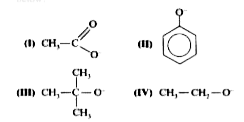Which of the following stability order of anions is/are correct :



ӨCH3I>ӨCD3II I>II
The correct Answer is:A, B, C, D
To determine the correct stability order of anions, we need to analyze the factors that influence the stability of anions, such as resonance, inductive effects, and the electronegativity of atoms involved.
1. Identify the Anions in Each Option:
- Look at the anions mentioned in each option. For example, you might have anions like NO2^-, CN^-, Cl^-, etc.
2. Consider Resonance Effects:
- Anions that can delocalize their negative charge through resonance are generally more stable. For example, the nitro group (NO2) can stabilize a negative charge through resonance.
3. Evaluate Inductive Effects:
- The inductive effect (I effect) refers to the electron-withdrawing or electron-donating effects of substituents. Electron-withdrawing groups (like NO2) stabilize negative charges, while electron-donating groups (like CH3) destabilize them.
4. Compare Stability:
- Based on the resonance and inductive effects, compare the stability of the anions. For example:
- NO2^- > CN^- > Cl^-
- This order indicates that NO2^- is the most stable due to resonance stabilization.
5. Analyze Each Option:
- Go through each option provided in the question and apply the above principles to determine if the stability order is correct.
6. Conclusion:
- After analyzing all options, conclude which stability orders are correct based on your evaluations.
- Look at the anions mentioned in each option. For example, you might have anions like NO2^-, CN^-, Cl^-, etc.
- Anions that can delocalize their negative charge through resonance are generally more stable. For example, the nitro group (NO2) can stabilize a negative charge through resonance.
- The inductive effect (I effect) refers to the electron-withdrawing or electron-donating effects of substituents. Electron-withdrawing groups (like NO2) stabilize negative charges, while electron-donating groups (like CH3) destabilize them.
- Based on the resonance and inductive effects, compare the stability of the anions. For example:
- NO2^- > CN^- > Cl^-
- This order indicates that NO2^- is the most stable due to resonance stabilization.
- Go through each option provided in the question and apply the above principles to determine if the stability order is correct.
- After analyzing all options, conclude which stability orders are correct based on your evaluations.
Topper's Solved these Questions
- GENERAL ORGANIC CHEMISTRY IIBOOK - RESONANCECHAPTER - GENERAL ORGANIC CHEMISTRY IIEXERCISE - Part-IV : Comprehension
14 Videos
- GENERAL ORGANIC CHEMISTRY IIBOOK - RESONANCECHAPTER - GENERAL ORGANIC CHEMISTRY IIEXERCISE - Exercise-3 Part:I JEE(Advanced)/IIT-JEE Problems (Previous Years)
17 Videos
- GENERAL ORGANIC CHEMISTRY IIBOOK - RESONANCECHAPTER - GENERAL ORGANIC CHEMISTRY IIEXERCISE - Part-II: Single And Double Value Integer Type
10 Videos
- GASEOUS STATEBOOK - RESONANCECHAPTER - GASEOUS STATEEXERCISE - PHYSICAL CHMISTRY (Gaseous State)
47 Videos
- GENERAL ORGANIC CHEMISTRY-IBOOK - RESONANCECHAPTER - GENERAL ORGANIC CHEMISTRY-IEXERCISE - PART-III : PRACTICE TEST-19
1 Video
Similar Questions
Knowledge Check
Which of the following stability order is correct ?
AO2−2>O−2>O2>O+2BO+2>O2>O−2>O2−2CO+2>O2>O−2>O2−2DO2>O+2>O2>O−2Which of the following thermal stability order is not correct :-
ANaHCO3<KHCO3<RbHCO3BCaO2>SrO2>BaO2CNa2SO4>MgSO4>Al2(SO4)3DCCl4>SiCl4>GeCl4>SnCl4Stability order of given anions is :
 AI>III>IIBI>II>IIICIII>II>IDIII>I>II
AI>III>IIBI>II>IIICIII>II>IDIII>I>II
Which of the following is correct order of stability?
View SolutionWhich of the following is the correct order of stability?
View SolutionWhich of the following is correct order of stability of carbocation?

View SolutionWhich of the following is the correct order of stability of free radicals ?
View SolutionWhich of the following is the correct order of stability of free radicals?
View Solution

